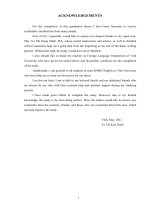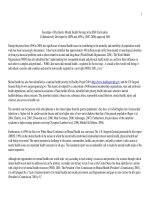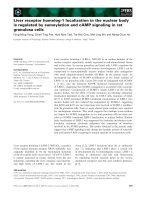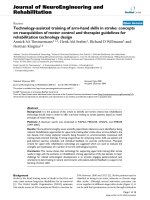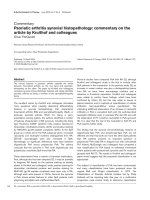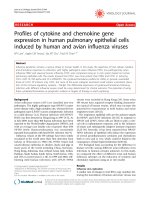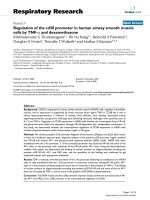MODALITY IN TED TALKS ON GENDER EQUALITY BY NATIVE AND NON NATIVE ENGLISH SPEAKERS a SYSTEMIC FUNCTIONAL ANALYSIS
Bạn đang xem bản rút gọn của tài liệu. Xem và tải ngay bản đầy đủ của tài liệu tại đây (1.25 MB, 92 trang )
VIETNAM NATIONAL UNIVERSITY, HANOI
UNIVERSITY OF LANGUAGES AND INTERNATIONAL STUDIES
FACULTY OF LINGUISTICS & CULTURES OF ENGLISH-SPEAKING
COUNTRIES
GRADUATION PAPER
MODALITY IN TED TALKS ON GENDER EQUALITY
BY NATIVE AND NON-NATIVE ENGLISH
SPEAKERS: A SYSTEMIC FUNCTIONAL ANALYSIS
Supervisor: Trương Thị Ánh, M.A.
Student: Cao Thị Bảo Ngọc
Course: QH2017.F1.E2
HÀ NỘI – 2021
ĐẠI HỌC QUỐC GIA HÀ NỘI
TRƯỜNG ĐẠI HỌC NGOẠI NGỮ
KHOA NGƠN NGỮ VÀ VĂN HĨA CÁC NƯỚC NĨI TIẾNG ANH
KHĨA LUẬN TỐT NGHIỆP
TÌNH THÁI TRONG CÁC BÀI DIỄN THUYẾT
TEDTALKS VỀ BÌNH ĐẲNG GIỚI CỦA NGƯỜI BẢN
NGỮ VÀ NGƯỜI KHƠNG PHẢI NGƯỜI BẢN NGỮ
TIẾNG ANH: PHÂN TÍCH NGỮ PHÁP CHỨC NĂNG
HỆ THỐNG
Giáo viên hướng dẫn: Th.S Trương Thị Ánh
Sinh viên: Cao Thị Bảo Ngọc
Khóa: QH2017.F1.E2
HÀ NỘI – 2021
ACCEPTANCE PAGE
I hereby state that I: Cao Thi Bao Ngoc, QH2017.F1.E2, being a candidate for
the degree of Bachelor of Arts (Fast-track programme) accept the requirements
of the College relating to the retention and use of Bachelor’s Graduation Paper
deposited in the library.
In terms of these conditions, I agree that the origin of my paper deposited in the
library should be accessible for the purposes of study and research, in
accordance with the normal conditions established by the librarian for the care,
loan or reproduction of the paper.
Signature
Ha Noi, May 4th 2021
ACKNOWLEDGEMENTS
I would like to express my deepest gratitude to all of those who made this
paper possible.
First and foremost, I am immensely grateful towards all ULIS lecturers
who always support and encourage me throughout my journey at ULIS with their
expertise and invaluable personal experience. My inferiority complex has always
been a burden in my learning, but with their constant appreciation, I become
more confident in my ability, gain profound knowledge of different aspects and
become a better version of myself. They are the reason why I really enjoy my
time here with wonderful memories.
Secondly, I want to express my heartfelt thankfulness to Ms. Truong Thi
Anh for accepting to be my supervisor. I would not have been able to complete
my thesis without her continuous guidance and constructive comments
throughout the conduct of this paper. Her suggestions are of great help whenever
I find myself in confusion. I am extremely appreciative of her tolerance even
when I pose a lot of inquiries and sometimes slack off in my progress.
Thirdly, I would also want to express my appreciation to my family
members. They have been my solid backing who I can lean on for mental support
to overcome all the adversities along the way. They respect all my decisions and
support me at their best.
Furthermore, to all of my beloved friends, I would like to acknowledge
with sincere thanks their existence in my life. They all comprise an important
part of my youth. My gratitude to my research team, Ha Trang, Khanh Huyen
and Thu Trang, who stay with me as teammates, as best friends, who can share
with me all the concerns and urge each other to strive for the best. I also want to
thank Thu Trang and Tam Nguyen for their advice on my topic whenever I do
not understand something. Moreover, my special friends, Dong Linh, Ngan Ha,
Hai Ha, Cam Ha, Phuong Nhung, Quynh Mai, Quynh Anh and Khanh Hoa, they
have patiently listened to my grumbles because of stress, lifted my mood and
i
encouraged me all the time, for which I am profoundly grateful. Without them, I
would have given up midway.
Finally, I greatly value the spiritual strength that I gain from my idols,
especially Wanna One members and Chuang trainees. They are my inspirational
role models when it comes to a never-giving-up spirit. Thanks to them, I learn to
put enormous effort in everything I do. They are also my source of delight during
the time I feel stuck accomplishing this paper.
ii
ABSTRACT
Modality, which is a rather complicated concept, functions importantly in
the formation of arguments in both spoken and written discourse; therefore, it
needs to be thoroughly investigated. However, academic research concerning
modality system and the comparison between the utilization of modality in
speeches by native and non-native English speakers has been relatively limited
in number. Consequently, this study was conducted to discover the modality
system regarding type, value and orientation which was applied by both native
and non-native English speakers in 10 speeches of TEDTalks on gender equality.
The analytical framework was based on Halliday’s systemic functional
linguistics. Moreover, purposive sample, quantitative, and qualitative
approaches were used to analyze the data. The results revealed that modality was
realized in all four sub-types, especially probability and obligation. Moreover,
three scales in value and four aspects in orientation could be seen in the chosen
speeches. Both the native and non-native English speakers share the similarities
in favoring probability, median value, and implicit subjective orientation.
However, the non-native English speakers employed more inclination as well as
high and low value modality expressions than the natives did. Additionally, the
natives were more explicit and more objective in their propositions than the nonnatives. Especially, the natives utilized a wide range of modality markers, while
the non-natives mostly made use of modal auxiliaries. The study yields useful
pedagogical implications for applying modality efficiently in oral presentations.
Keywords:
TEDTalks, gender equality, modality, native speakers, nonnative speakers
iii
TABLE OF CONTENTS
ACKNOWLEDGEMENTS ............................................................................... i
ABSTRACT ...................................................................................................... iii
TABLE OF CONTENTS ................................................................................. iv
LIST OF TABLES, FIGURES AND ABBREVIATIONS ........................... vi
CHAPTER 1: INTRODUCTION .................................................................... 1
1.1. Rationale ................................................................................................... 1
1.2. Aims and research questions ..................................................................... 2
1.3. Scope of the study ..................................................................................... 3
1.4. Significance of the study ........................................................................... 3
1.5. Methods of the study ................................................................................. 4
1.6. An overview of the rest of the paper ......................................................... 4
CHAPTER 2: LITERATURE REVIEW ........................................................ 6
2.1. Systemic Functional Grammar.................................................................. 6
2.2. Modality .................................................................................................... 7
2.2.1. Modality and Polarity ......................................................................... 7
2.2.2. Types of modality ............................................................................... 8
2.2.3. Value of modality ............................................................................... 9
2.2.4. Orientation of modality ...................................................................... 9
2.2.5. Realization of modality .................................................................... 10
2.3. Native and non-native English speakers ................................................. 14
2.4. Previous studies on modality .................................................................. 15
CHAPTER 3: METHODOLOGY ................................................................. 20
3.1. Data description ...................................................................................... 20
3.2. Data collection ........................................................................................ 21
3.3. Data analysis method .............................................................................. 23
3.4. Data analysis procedure .......................................................................... 26
CHAPTER 4: FINDINGS AND DISCUSSION ........................................... 27
4.1. Research question 1: Modality realization in terms of type, value, and
orientation ...................................................................................................... 27
4.1.1. Type .................................................................................................. 27
iv
4.1.2. Value ................................................................................................. 31
4.1.3. Orientation ........................................................................................ 33
4.2. Research question 2: Similarities and differences in the use of modality
between native speakers (NS) and non-native speakers (NNS) of English ... 35
4.3. Discussion ............................................................................................... 41
4.3.1. Modality realization .......................................................................... 41
4.3.2. Similarities and differences in modality usage between NS and NNS
of English .................................................................................................... 44
CHAPTER 5: CONCLUSION ....................................................................... 47
1. Summary .................................................................................................... 47
2. Implications ................................................................................................ 48
3. Limitations and suggestions for further study............................................ 49
REFERENCES ................................................................................................ 51
APPENDIX ...................................................................................................... 60
v
LIST OF TABLES, FIGURES AND ABBREVIATIONS
Table 2.1.
The basic speech roles
8
Table 2.2.
Values of modality
9
Table 2.3.
Modality: examples of type and orientation combined
10
Table 2.4.
Modal operators
11
Table 2.5.
Modal adjuncts
11
Table 2.6.
Types of modality and their typical realizations
13
Table 2.7.
Expressions of probability
14
Table 3.1.
Analytical framework (Modalization)
24
Table 3.2.
Analytical framework (Modulation)
25
Table 4.1.
Distribution of each type of modality
27
Table 4.2.
Distribution of modal value
31
Table 4.3.
Distribution of modal value according to type
31
Table 4.4.
Distribution of each type of modality orientation
33
Table 4.5.
Distribution of modality orientation according to type
34
Table 4.6.
Comparison of modality sub-type between NS and NNS
35
Table 4.7.1 Comparison of modality value between NS and NNS
37
Table 4.7.2. Comparison of modality value according to sub-types between
Table 4.8.
NS and NNS
38
Comparison of modality orientation between NS and NNS
39
Figure 2.1. Types of modality
9
Figure 3.1. Modality system
23
Figure 4.1. Comparison of the percentage of modality sub-types in each
corpus between NS and NNS
36
Figure 4.2. Comparison of the percentage of modality value in each corpus
between NS and NNS
37
Figure 4.3. Comparison of the percentage of modality orientation in each
corpus between NS and NNS
vi
40
NNS:
Non-native speakers of English
NS:
Native speakers of English
SFL:
Systemic functional linguistics
vii
CHAPTER 1: INTRODUCTION
1.1. Rationale
Language is never a one-way transmission of messages, but rather an
interactive process which involves speaker/writer and the audience (Halliday,
1994). Speakers/writers use language not only to describe things but also to
express their opinions, to establish and maintain relationships and to influence
others’ attitudes and behavior (Thompson, 1996). The latter refers to
interpersonal metafunction of language. According to Halliday’s systemic
functional linguistics (SFL), one main way to realize interpersonal meanings is
modality, a means to convey speakers’ level of certainty and commitment to their
propositions and readers/listeners. This linguistic phenomenon plays an
important role in argument formation in both written and spoken discourse
(Rocci, Rocci & Olivier, 2017; Letica, 2008) and a central element for successful
academic communication as claims and assertions need to be “warranted” and
“reflect appropriate social interactions” (Hyland & Milton, 1997, p. 183). In
addition, knowledge of modality is of great help to L2 learners so that they have
at their disposal a repertoire of expressions “that allow them to make claims with
the exact degree of certainty or doubt that they intend” (McEnery & Kifle, 2002,
p. 183).
Despite the effectiveness of modality in building argument and conveying
assessment, previous literature indicates that non-native language users often
have difficulty in interpreting and utilizing different degrees of assertion
precisely. They often resort to narrower choices of modality expressions and an
inappropriate overuse of stronger/ weaker commitment compared to native
speakers (Kärkkäinen, 1992; Hyland & Milton, 1997; Letica, 2008). These
problems can be attributed not only to the complexity of modality in terms of
multiple realizations and semantic meanings, L1 influence and cross-cultural
interference but also to lack of guidance and practice on the correct use of modal
devices in traditional classrooms and academic materials (Flowerdew, 2001;
1
Hyland & Milton, 1997). Therefore, the researcher wants to investigate the use
of modality in Ted Talks, an authentic source of materials that is increasing in
popularity in teaching and learning English. An insight into how inspiring
thinkers at TED made efficient use of modality in their talks to influence the
audience would carry considerable pedagogical implications for English
language teachers and learners.
Moreover, comparison in the use of modality between native and nonnative speakers is mostly associated with written discourse such as academic
essays (Hyland & Minton, 1997; Lorenzo, 2008; Chen, 2010; Hu & Li, 2015).
Concerning spoken discourse, not much attention has been paid to the
discrepancy in modality usage between speeches delivered by English native and
non-native speakers (Ton Nu & Nguyen, 2019) as they only concerned problems
encountered by non-native speakers in using modality in conversations (Coates,
1987; Kärkkäinen, 1992) or performing language tasks (Letica, 2008). This
leaves a gap for the researcher to explore the pattern in TED talks to see whether
the aforementioned claims can be applied in speeches. Additionally, previous
studies often focused on epistemic modality, which refers to the validity of the
proposition, with little consideration of the degree of obligation/ willingness
entailed in the utterances. Considering that TED talks also aim to trigger
behavior/ attitude change, the researcher finds it necessary to take into account
that category of modality too.
In short, personal concerns about the difficulty encountered by foreign
language users in understanding and using modality and the scarcity of literature
in investigating speeches made by native and non-native speakers lead the
researcher to study the realization of modality in Ted Talks and differences in
the utilization of modality between first and foreign language users.
1.2. Aims and research questions
In order to identify how speakers at TED talks utilized modality in their
speeches and compare the use of modality between native and non-native
speakers, this study seeks to provide answers to the following research questions:
2
1. How is modality realized (in terms of type, value and orientation) in
TED talks on gender equality?
2. What are the similarities and differences in the use of modality
between native and non-native speakers of English?
1.3. Scope of the study
In this research, the focus is on modality usage in public speeches. It can
be noted that in spoken discourse, modality can be expressed through not only
lexical items but also other non-lexical devices like paralinguistic or prosodic
aspects (Coates, 1987; Letica, 2008). However, in this study, the researcher will
only focus on linguistic realization of modality. Other devices, therefore, will not
be taken into consideration.
The samples used as data for analysis are 10 speeches on gender equality
taken from TED or TEDX Talks Youtube channel. Among them, 5 are produced
by native English speakers and the rest belong to non-native English users.
1.4. Significance of the study
The findings of this study are expected to facilitate teachers to make more
effective use of TED talks as an instructional material. One main reason students
have difficulty in interpreting and utilizing appropriate degrees of modality is
lack of instruction and practice as well as lack of focus on this domain in
traditional academic materials (Hyland & Milton, 1997). TED talks prove to be
a suitable source of modality samples that teachers can use as the nature of these
speeches is to express opinions and influence the attitude and behavior of the
audience. With an insight into modality patterns in terms of different linguistic
devices and various levels of commitment in TED talks, educators can integrate
this element into the lesson.
The information presented is also hoped to enable students to develop an
awareness of the necessity and the way to make a proper use of modality in their
language production. The list of expressions denoting different levels of certainty
and commitment can serve as a reference for students so that they can interpret
3
utterances correctly and express their personal opinions precisely and
effectively. These abilities are of great importance in both written and spoken
discourse, and the input from TED talks can especially be useful for public
speaking and oral presentations.
As there were few studies investigating the use of modality in TED talks,
specifically the obligation/ willingness aspect of modality and the comparison
between native and non-native speakers in speeches, the outcome of this research
can also be a source of reference for other researchers with the same interest.
1.5. Methods of the study
To achieve the aforementioned aims, the researchers mainly utilize two
methods: qualitative and quantitative. Qualitative method is employed to analyse
the transcripts to find out the realizations of modality, categorise them according
to type, value and orientation and discuss research results. Quantitative method
concerns with calculating the data into percentages and frequency of each
modality marker. The analysis of modality in terms of type, value and orientation
is based on Halliday’s systemic functional linguistics framework.
1.6. An overview of the rest of the paper
The rest of the paper consists of four chapters as follows:
Chapter II: Literature review
This chapter examines the background of the study, including theoretical
framework and previous studies in the field.
Chapter III: Methodology
This chapter provides information concerning corpus selection, data collection
and analysis instruments and procedures employed in the research.
Chapter IV: Findings and Discussion
This chapter presents, analyzes and discusses the findings from the data collected
according to two research questions.
4
Chapter V: Conclusion
This chapter summarizes the main issues discussed in the paper, limitations of
the study as well as some suggestions for further research.
Following this chapter are the References and Appendices.
5
CHAPTER 2: LITERATURE REVIEW
2.1. Systemic Functional Grammar
As humans started to be concerned about the languages they use to speak
and write and began analyzing them in the early 18th century, the field of
linguistics was born and has received great popularity since then. Throughout
the years, it has been developed and witnessed a great change in the advent of
various
approaches
to
grammatical
analysis,
such
as
Chomsky’s
transformational generative grammar and Bloomfield’s structural tradition.
Among those theories, functional approach is considered a milestone in the
development of world linguistics. Unlike traditional grammar, which treats
grammar as “a set of rules which specify all the possible grammatical structures
of the language where grammatical and ungrammatical sentences are
distinguished clearly” (Lock, 1996, p. 1), functional grammar describes
relationships between grammatical structures and meaning (Thompson, 1996).
To be more specific, it concerns the choices of grammatical patterns and lexical
items in text “as a means to interact with each other” (Martin, Matthiessen &
Painter, 1997, p. 1). Halliday (1994) also shared the same idea when he identified
the purpose of functional grammar, which is to examine and interpret the
wording with regard to the meaning in order to “make it possible to say sensible
and useful things about any text”.
This thesis adopts the framework of Systemic Functional Linguistics
(SFL), a combination of systemic grammar and functional grammar, proposed
and developed by M.A.K. Halliday (Halliday, 1978, 1994; Halliday &
Matthiessen, 2004). Recognizing language as a meaning-making instrument in
context and a network of systems of choices, SFL examines how our linguistic
selection shapes and is shaped by social contexts to express different meanings.
According to this linguistic theory, there are three lines of meanings occurring
simultaneously in every clause we make corresponding with three metafunctions
that language plays: ideational, interpersonal and textual. Ideational
metafunction refers to the use of language to construe our experience of the
6
world around us and our inner world. Another line of meaning, interpersonal,
considers language a resource to interact, establish and maintain social
relationships with other people. Meanwhile, textual metafunction concerns how
messages are organized to fit in with the prior and following text and the context
language is used (Thompson, 1996). These three metafunctions contribute
equally to the meaning of the message as a whole.
The focus of this study is on interpersonal metafunction, which is related
to the role of language as an interaction between speakers/writers and the
audience. It also involves the “speakers’ subjectivity—their assessment of
probability, obligation, and commitment, their attitudes and evaluation” (Hasan
& Perrett, 1994, p. 183), which is typically expressed by the use of modality
resources of the language.
2.2. Modality
2.2.1. Modality and Polarity
In SFL, the concept of modality is closely related to polarity. Polarity is
defined as “the choice between positive and negative as in is/isn’t, do/don’t”
(Halliday, 1994, p. 88). Therefore, it has been treated as an absolute scale of “yes
or no”. However, when we communicate, the choices are not just limited to “yes
or no”. In fact, there is a modal space that comes in between, which allows
speakers/writers to convey their judgements and opinions on the utterances. The
intermediate degrees between positive and negative polarity are called modality,
“intermediacy expressions” (Matthiessen, Teruya & Lam, 2010, p. 141). In other
words, it “refers to the meaning that lies between yes and no—the intermediate
ground between negative and positive polarity” (Halliday & Matthiessen, 2014,
p. 691). According to Gerot and Wignell (1994), modality expresses the
speaker’s judgment of the probabilities or the obligations involved in what he/she
is saying.
7
2.2.2. Types of modality
In order to classify modality, Halliday (2000) referred to the distinction
of utterances based on various kinds of “commodity exchanged” and “speech
roles” (as can be seen in Table 2.1).
Table 2.1. The basic speech roles (Halliday, 2000, p. 69)
Role in exchange
Commodity exchanged
Information
Goods and services
Giving
Statement
Offer
Demanding
Question
Command
If the commodity exchanged in a clause is information, it is defined as a
proposition (statements and questions). In a proposition, positive and negative
polarity are equivalent to absolute assertion and denial. In this case, modality is
related to the validity of the information with regard to probability (the likelihood
for the information to be true) or usuality (the frequency that it is true)
(Thompson, 1996). Halliday (1994) refers to these sub-categories as
modalization. On the other hand, if goods-&-services is what is exchanged, it is
a proposal (offers and commands). The two polarities in a proposal are
prescribing and proscribing. Lying between these polarities is modality
expressing the confidence of the speaker in the eventual success of the exchange
(Thompson, 1996). There are two scales of intermediate possibility in this case,
which are obligation (the force on the listeners to carry out the action) and
inclination (the willingness of the speaker in fulfilling the offer). The modality
of obligation and inclination is called modulation.
8
Figure 2.1. Types of modality (Thompson, 1996, p. 58)
2.2.3. Value of modality
As modality involves scales, each modality expression can convey
different degrees of meaning. Halliday (2000) assigned three basic values to
modality: high, median and low, which is illustrated in Table 2.2. The
classification of value of modality is useful to investigate the speaker’s
commitment to the utterances like degree of certainty about the validity of the
information or degree of the force on other people to complete the action and
carries considerable implications for text analysis (Thompson, 1996).
Table 2.2. Values of modality (Halliday, 2000, p. 358)
Probability
Usuality
Obligation
Inclination
High
Certain
Always
Required
Determined
Median
Probable
Usually
Supposed
Keen
Low
Possible
Sometimes
Allowed
Willing
2.2.4. Orientation of modality
According to Halliday (2000), “the basic distinction that determined how
each type of modality will be realized is the orientation” (p. 357). It is first
divided into subjective, when the utterance is the speaker’s point of view, and
objective, when the speaker disguises his/her own judgement as something
9
attributed to the proposition. For example, a speaker can state whether the
probability is subjective or objective by adding a projection “I think”
(subjectivity) or “It is likely” (objectivity). Moreover, when uttering something,
people can choose whether to state it directly or indirectly, that is why orientation
is further divided into explicit and implicit. Halliday (2000) summarized and
gave examples of four kinds of modality orientation in combination with type as
follows:
Table 2.3. Modality: examples of type and orientation combined (Halliday,
2000, p. 358)
Subjective:
Subjective:
Objective:
Objective:
explicit
implicit
implicit
explicit
Mary
It’s likely that
opinion] Mary
probably
Mary
knows
knows [in all [Mary is likely
Modalization I think [in my Mary’ll know
: probability
probability]
Modalization
Fred’ll
sit Fred
: usuality
quite quiet
knows
to]
usually It’s usual for
sits quite quiet Fred
to
sit
quite quiet
Modulation:
I want John to John
obligation
go
should John’s
go
supposed
It’s expected
to that John goes
go
Modulation:
Jane’ll help
Jane’s keen to
help
inclination
2.2.5. Realization of modality
There are a wide range of variants to express modality in the clause.
Halliday (2000) identified three main ways that probability and usuality can be
realized, which are (a) a finite modal operator (as shown in Table 2.4), (b) a
10
modal adjunct (as summarized in Table 2.5) and (c) a combination of both. The
following examples with modality signals in italics are given to exemplify his
category:
(a) That will be John, he’ll sit there all day.
(b) That’s probably John, he usually sits there all day.
(c) That’ll probably be John, he’ll usually sit there all day.
With regard to obligation and inclination, Halliday (1994) summarized
their realizations into either of two typical ways: (a) a finite modal operator (as
shown in Table 2.4) or (b) an expansion of the Predicator (i) a passive verb or
(ii) an adjective. Here are some examples to illustrate the points:
(a) You should know that, I will help them.
(b) (i) You are supposed to know that
(ii) I’m anxious to help them.
Table 2.4. Modal operators (Halliday, 2000, p. 76)
Low
Positive
Negative
can,
may,
Median
High
could, will, would, should, must, ought to, need,
might (dare)
is/was to
needn’t,
won’t,
doesn’t/didn’t
has/had to
wouldn’t, mustn’t, oughtn’t to,
+ shouldn’t,
need to, have to
(isn’t/wasn’t to)
can’t,
couldn’t,
(mayn’t,
mightn’t,
hasn’t/hadn’t to)
Table 2.5. Modal adjuncts (Halliday, 2000, p. 49)
Type
Probability
Meaning
Examples
how
probably, possibly, certainly, perhaps,
likely?
maybe
how
usually,
I
Usuality
11
sometimes,
always,
(n)ever,
Typicality
obviousness
often?
often, seldom
how
occasionally, generally, regularly, for the
typical?
most part
how
of course, surely, obviously, clearly
obvious
Opinion
I think
in my opinion, personally, to my mind
admission
I admit
frankly, to be honest, to tell you the truth
persuasion
I
assure honestly, really, believe me, seriously
you
Entreaty
I
request please, kindly
you
II
presumption I presume
evidently,
apparently,
no
doubt,
presumably
desirability
how
(un)fortunately, to my delight/distress,
desirable? regrettably, hopefully
reservation
validation
evaluation
prediction
how
at first, tentatively, provisionally, looking
reliable?
back on it
how
broadly speaking, in general, on the
valid?
whole, strictly speaking, in principle
how
(un)wisely, understandably, mistakenly,
sensible?
foolishly
how
to my surprise, surprisingly, as expected,
expected?
by chance
12
The main categories of modality as well as their typical realizations in
the clause can be summarized as follows:
Table 2.6. Types of modality and their typical realizations (Halliday,
2000, p. 91)
Types of modality
Typical realization
Modalization Probability Finite modal operator
Example
They must have known
Modal adjunct
They certainly knew
(both the above)
They certainly must have
known
Usuality
Modulation
Obligation
Finite modal operator
It must happen
Modal adjunct
It always happen
(both the above)
It must always happen
Finite modal operator
You must be patient!
Passive verb predicator You’re required to be patient!
Inclination Finite modal operator
Adjective predicator
I must win!
I’m determined to win!
Moreover, Halliday (1994) also added the concept of grammatical
metaphors as a realization of modality, often in the form of a separate projecting
clause. Grammatical metaphors can also be realized by a prepositional phrase
such as “in my opinion” (subjectivity) and “in all probability” (objectivity) or
nominalization (The likelihood of ….). With this type, the speaker can show
explicitly whether it is his/ her subjective opinion or it is an objective point of
view by making it “a quality of the event itself” (Thompson, 1996, p. 60). This
concept helps in distinguishing modality orientation. For example, in the case of
probability, Halliday (2000) presented examples of the principal categories:
13
Table 2.7. Expressions of probability (Halliday, 2000, p. 355)
Category
Type of realization
Example
(1) Subjective
(a) explicit
I think, I’m certain
I think Mary knows
(b) implicit
will, must
Mary’ll know
(a) implicit
probably, certainly
Mary probably knows
(b) explicit
It’s likely, It’s certain
It’s likely Mary knows
(2) Objective
Overall, explicit subjective orientation can be realized by a projecting
clause and modal full verbs, while implicit subjective orientation is expressed
through finite modal operators. Moreover, implicit objective is through modal
adjuncts and passive verb predicators, while explicit objective is realized by a
separate clause and nominal modal expressions.
2.3. Native and non-native English speakers
There are different notions regarding how to define these terms.
According to Oxford Learner’s Dictionaries, “native speakers” (NS) are those
who speak a language as their first language and have not learned it as a foreign
language. Meanwhile, Cambridge Dictionary defines them as “someone who has
spoken a particular language since they were a baby, rather than having learned
it as a child or adult.” In the context of this paper, an English native speaker is
someone who has learned English as first language since childhood. These
speakers belong to Inner Circle in Kachru’s model (1985), which include
countries like USA, UK, Ireland, Canada, South Africa, Australia and New
Zealand. Non-native speakers (NNS) of English, on the other hand, are people
who speak English as second or foreign language, but have a different language
as native language.
14
2.4. Previous studies on modality
Interpersonal meaning has been an area of interest for researchers in both
written and spoken discourse. Regarding written discourse, there have been
many attempts in investigating interpersonal metafunctions, especially modality,
in different genres like newspaper articles (Odhiambo & Odhiambo, 2020;
Muhammad, Muhammad & Muhammad, 2019; Sadia & Ghani, 2019), microblogging news (Rui & Jingxia, 2018), students’ academic writings (Hu & Li,
2015; McEnery & Kifle, 2002) and textbooks (Hoang, 2019).
Interpersonal meaning in spoken discourse, especially public speeches,
also received great concern from linguists as this means of communication
specifically requires effective interaction between speakers and listeners.
However, in spoken discourse, many researchers only focused on the choice of
moods, speech functions and their relation with power distance without
considering modality when investigating the interpersonal meaning employed by
speakers (Ezeifeka, 2013; Sari, 2014; Shanty, 2014). According to Martin (2000)
and Hunston (2000), mood and tense systems are not enough to completely
describe the interpersonal function of language in discourse. Other semantic
elements such as modality to express evaluation should be added.
Therefore, other studies often incorporated modality as part of their data
analysis together with mood and personal pronouns. Comparing election
speeches delivered by Hillary and Trump, Ping and Lingling (2017) found out
that both speakers used different kinds of modal auxiliary and tended to use more
median modal operators “will, would, should” to make their speeches less
aggressive. Similar results were found when Satvitri & Warsono (2019)
examined the interpersonal meaning Trump utilized in his victory speech, Feng
and Liu (2010) analyzed Obama’s opening speech at a news conference, in
Mandela's presidential inauguration speech (Nur, 2015) and in Obama and
McCain’s election speeches (Jin & Lu, 2013) as “will'' was also the most
dominant type. Meanwhile, in a research on Obama’s 2016 WHCD Address,
Chen and Shuo (2018) found a tendency of using low and median modal verbs
to make the audience more receptive. This was also the case of Susilo Bambang
15
